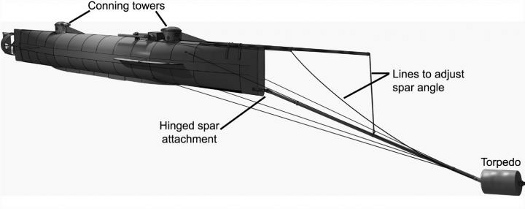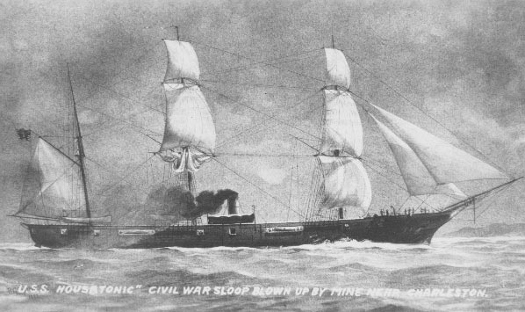 |
| January 16, 2018 | Volume 14 Issue 02 |
Designfax weekly eMagazine
Archives
Partners
Manufacturing Center
Product Spotlight
Modern Applications News
Metalworking Ideas For
Today's Job Shops
Tooling and Production
Strategies for large
metalworking plants
Mystery of Civil War sub crew deaths solved scientifically?
Researchers constructed a scale model of the sub, which was the first to sink an enemy ship in combat, and exposed it to underwater blasts to calculate the risk of injury.
Edited by Mike Foley, Designfax
The crew of the 40-ft-long Civil War submarine HL Hunley likely died from airblast injuries, according to a new study published Aug. 23, 2017, in the open-access journal PLOS ONE by Rachel Lance and her colleagues from Duke University.
The Confederate submarine HL Hunley sank the Union ship USS Housatonic on Feb. 17, 1864, at the outer entrance to Charleston Harbor by setting off a 135-lb black powder torpedo, which the sub's spar held at a downward angle, against the Housatonic's hull.

The HL Hunley as it would have appeared in attack position on the evening of Feb. 17, 1864. [Credit: Lance et al (2017)]
Following its attack on the Union ship, however, the Hunley also sank. Nonetheless, the Hunley is credited with the world's first sinking of a ship in combat by an enemy submarine.
When the submarine was raised from the ocean floor in 2000, the skeletons of its eight crewmembers were found seated at their respective stations inside the 4-ft-tall hull, with no physical injuries or indications that they were attempting to escape. More than 150 years later, it's still not clear how the crew of the HL Hunley died.
"Two previous primary theories of sinking -- suffocation and damage to the hull from arms fire -- have been found to be implausible in recent publications," the new study says.
Although many theories have been put forward about the mystery through the years, this is one of the first to take on the airblast premise scientifically.

The USS Housatonic was sunk after the Confederate submarine HL Hunley rammed a spar torpedo into its starboard side.
The Housatonic was a 1,240-ton wooden-hulled, steam-powered sloop-of-war armed with 12 large cannons. The small, sleek Hunley, in contrast, was made up of some 40 iron plates and featured a simple hand-cranked propulsion system that could do a max 4 knots, requiring seven crew members to turn the propeller and one to steer and direct the boat.
According to the website Friends of the Hunley, "When the Hunley was recovered, signs of obvious damage were noticed immediately, including a large hole in the aft ballast tank. ... However, most of the damage happened slowly over time while the Hunley rested on the ocean floor for over a century. In fact, much of the damage to the sub is the result of unforgiving underwater currents and scouring sand."
Interestingly, this was not the first sinking of the HL Hunley, which lost a total of 21 crewmen in three sinkings during its six months total of service. Twice before the final incident, it sank and was raised. The second time, it claimed the life of its inventor and namesake, Horace Lawson Hunley, who was not a service member.
To recreate and measure the black powder explosion that occurred in 1864, Lance and colleagues constructed a scale model of the HL Hunley, named the CSS Tiny, and exposed it to underwater blasts. An internal pressure gauge at the center of the Tiny measured the pressure inside the cabin generated by each blast. The experiment was scaled so that the force of the blast transmitted in the same way as the pressure transmission into the HL Hunley. This data was used in combination with archival experimental data to calculate the risk to the cabin crew from its own torpedo.
VIDEO: Confederate sailors on HL Hunley killed by their own weapon? [Duke University]
While the actual blast transmission of the HL Hunley is likely underestimated in this scaled model, the strength of the blast was estimated to be sufficient enough to cause pulmonary and brain trauma to the cabin crew. Therefore, the authors suggest that the blast wave transmitted from the Hunley's hull to its cabin likely killed its crew.
Lance's study concludes: "A common misconception is that people exposed to blast are always physically thrown by the blast (e.g. in movies or television). However, blasts too weak to move or translate a human body noticeable distances are still often intense enough to cause lethal pulmonary trauma. ...
"Respiratory distress is one of the hallmarks of pulmonary blast injury; even if any crewmen had survived the initial blast they would have likely still been above the injury threshold and would have experienced symptoms such as shortness of breath, hemoptysis, tachypnea, and hypoxia.
"Therefore, even if some crewmen had survived the initial blast they would have likely been crippled in terms of respiration and physically unable to power the handcrank to move the submarine. If anyone had survived, they may have tried to release the keel ballast weights, set the bilge pumps to pump water, or tried to get out the hatches, but none of these actions were taken."
"The disappearance of the Hunley has long stood as one of the great mysteries of American history," says Lance. "Finding the cause of death of the crew has finally allowed us to declare the mystery solved."
VIDEO: The HL Hunley story by Bill Kendall (not associated with Duke University or its airblast study, but a very interesting retelling).
VIDEO: See what the Hunley looks like now -- crew compartment becomes visible. [Friends of the Hunley]
The Friends of the Hunley "Evidence" page has more interesting details about the exact condition of the sub and its crew when found initially in 1995. The website also names three other theories for the Hunley's demise.
The Hunley is on display in a 90,000-gal freshwater conservation tank in Charleston, SC, at the Warren Lasch Conservation Center.
CITATION:
Lance RM, Stalcup L, Wojtylak B, Bass CR (2017) Air blast injuries killed the crew of the submarine H.L. Hunley. PLoS ONE 12(8): e0182244. https://doi.org/10.1371/journal.pone.0182244
Sources: Duke University, Military Wiki, Friends of the Hunley
Published October 2017
Rate this article
View our terms of use and privacy policy
